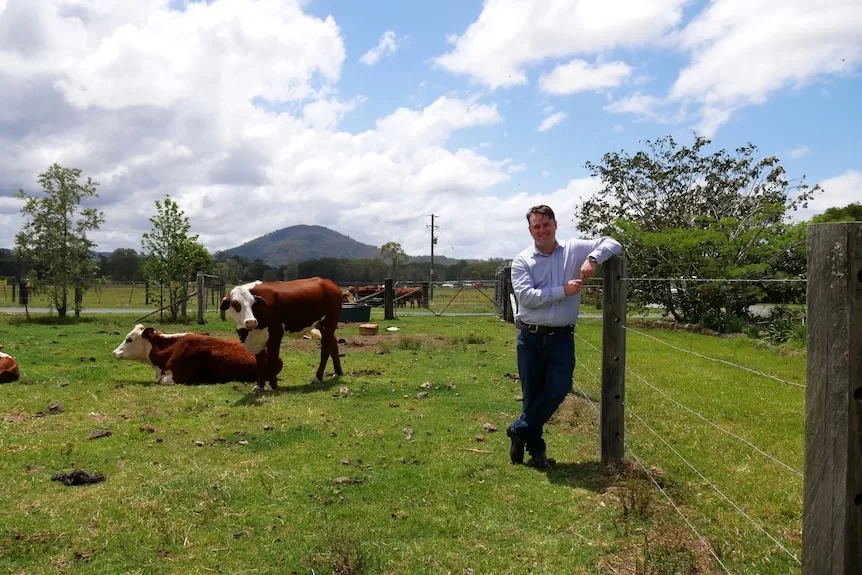Fourth-generation First Nations grazier Joshua Gilbert feels pride at his family’s farming history in Nabiac, which goes back thousands of years on Worimi Country on the New South Wales mid-north coast.
Key points:
- First Nations farmers make up 1 per cent of Australia’s agriculture sector
- Joshua Gilbert’s PhD looks at ways to increase Indigenous participation
- The National Farmers Federation says its committed to elevating First Nations producers
But Mr Gilbert recognises his success story is a rarity in the sector, with the National Farmers Federation (NFF) estimating that Indigenous farmers make up fewer than 1 per cent of the workforce.
He said the actual rate could be higher, but First Nations producers were often unwilling to identify as Aboriginal.
His experience has inspired him to undertake a PhD focusing on Indigenous participation in agriculture at Charles Sturt University (CSU).
“The racism in the industry is something that needs to be addressed,” Mr Gilbert said.
“We know that there are mob who haven’t received fair prices, even recently, for their cattle because of their Indigenous heritage.”
Mr Gilbert said his research explored ways to increase and retain First Nations farmers.
“We need to support them to get involved in the sector and be able to do that and not fear that they’re going to receive less for their cattle, or for their commodity, and that they get the same prices,” he said.
Fair wages
Mr Gilbert said Indigenous people played a significant role in western agriculture, usually as labourers for white agriculturalists, with little to no remuneration until the passing of the Equal Wages Act of 1968.
He said the act meant that First Nations people had to be paid a fair and equal wage.
But the agricultural sector secured a three-year transition period that kept wages for Indigenous farmers low.
“Farmers were basically being able to label Aboriginal workers as ‘slow workers’, and paid cents [for every] dollar of the wages for that three-year transition period,” he said.
Once the law was fully enforced, Mr Gilbert said many Indigenous farmers were sacked as their bosses couldn’t afford to keep them on.
Mr Gilbert said this ideology had contributed to many First Nations people lacking the intergenerational wealth to begin their own farming operations.
“Because mob were kicked off their own land, that kind of wealth hasn’t been building in terms of the Indigenous economy for a long period of time,” he said.
Mr Gilbert is a descendant of Mary Anne Bugg, one of the country’s first female bushrangers, whose Aboriginal mother married a white agriculturalist in the 19th century.
“The reason we’re involved in ag is because we’ve been quite lucky really,” Mr Gilbert said.
“Back in the 1820s my family made a strategic choice to marry into the white society for their own protection.”
A way forward
In a statement to the ABC, the NFF acknowledged that First Nations participation was low and that the industry “needs to do better to connect and attract indigenous Australians to agriculture”.
Through his research, Mr Gilbert has proposed the creation of an Indigenous research and development corporation for First Nations agriculture, funded by levies already paid by producers on native land.
“That money would then be used to invest in our own research and development, whether that be western agricultural systems or also investing into Indigenous native foods; so bush foods, native grains,” he said.
While the NFF didn’t comment directly on Mr Gilbert’s recommendations and research, it referred to its report released in May about attracting and retaining First Nations farmers across the sector.
CSU Professor of Agriculture Jim Pratley, who is Mr Gilbert’s PhD supervisor, hopes Mr Gilbert’s research and suggestions will lead to stronger First Nations engagement across the sector.
“Their understanding, their links to some of the history that we don’t understand are going to be critical as we move forward,” Professor Pratley said.
“We’re world leaders at the moment in agriculture. We want to stay there and the only way we can is to be always on the lookout for new ideas and better ways of doing things.”
The men believe that Indigenous expertise was an “untapped resource”, and increased participation could help alleviate the labour shortages affecting the sector.
“We’re only producing 1,000 graduates for 6,000 or 7,000 jobs, so we’ve got a big void of people,” Professor Pratley said.
Mr Gilbert said he has been speaking to various research and development corporations about his research.
His PhD research paper will be published in the Australian Farm Institute Journal on December 13.
Get our local newsletter, delivered free each Friday
